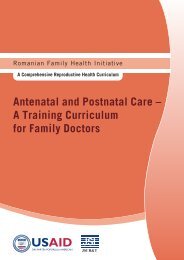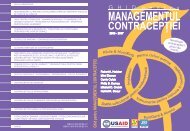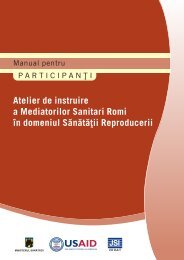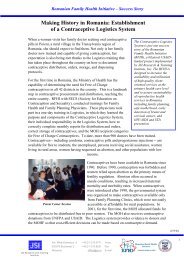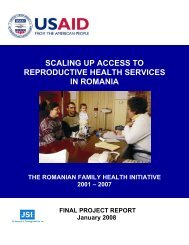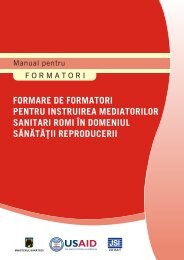Training of Roma Health Mediators in Reproductive Health
Training of Roma Health Mediators in Reproductive Health
Training of Roma Health Mediators in Reproductive Health
Create successful ePaper yourself
Turn your PDF publications into a flip-book with our unique Google optimized e-Paper software.
Distribute the participant document Ways to Significantly Reduce the Risk <strong>of</strong> Sexually<br />
Transmitted Infections.<br />
Close this part <strong>of</strong> the session with the follow<strong>in</strong>g po<strong>in</strong>ts:<br />
• All STIs can be prevented<br />
o We have the right and responsibility to keep ourselves healthy and to reduce<br />
the risk <strong>of</strong> STIs. Sometimes people:<br />
• Do not know that they are at risk <strong>of</strong> gett<strong>in</strong>g a sexually transmitted<br />
<strong>in</strong>fection.<br />
• F<strong>in</strong>d it hard to advocate for themselves or follow the practices that can<br />
keep them healthy.<br />
• Avoid tell<strong>in</strong>g their partners, even if they know they have a sexually<br />
transmitted <strong>in</strong>fection.<br />
o As we become more comfortable talk<strong>in</strong>g about STI risks with our partners and<br />
discuss<strong>in</strong>g how to keep each other healthy, it becomes easier to engage <strong>in</strong><br />
behaviors that significantly reduce the risk <strong>of</strong> <strong>in</strong>fection.<br />
• Most STIs can be treated. Early detection and treatment can significantly<br />
decrease serious complications, <strong>in</strong>clud<strong>in</strong>g <strong>in</strong>fertility <strong>in</strong> both men and women.<br />
• <strong>Mediators</strong> can <strong>of</strong>fer opportunities for community members to th<strong>in</strong>k about, discuss,<br />
and practice the communication skills they need to better advocate for their own<br />
reproductive health and reduce the risk <strong>of</strong> <strong>in</strong>fection. For example, they can help<br />
people to:<br />
o Improve their prevention practices<br />
o Monitor their health and behavior on a regular basis<br />
o Educate others about prevention <strong>of</strong> STIs, and about the importance <strong>of</strong> early<br />
detection and treatment for prevent<strong>in</strong>g serious complications<br />
o Request services if symptoms <strong>of</strong> STIs are noticed or if there is a chance <strong>of</strong><br />
<strong>in</strong>fection<br />
Inform people that they can choose an appropriate family plann<strong>in</strong>g method depend<strong>in</strong>g<br />
upon whether they are at risk or are suffer<strong>in</strong>g from STIs or not (for example, IUD should<br />
not be <strong>in</strong>serted <strong>in</strong> a women with and STI or PID; condoms may be used <strong>in</strong> association<br />
with other contraceptive method if any risk <strong>of</strong> STIs is suspected).<br />
III.<br />
HIV/AIDS (40 m<strong>in</strong>utes)<br />
Briefly expla<strong>in</strong> what HIV/AIDS is:<br />
• AIDS (Acquired Immune Deficiency Syndrome) is a fatal and dangerous disease. It is<br />
spread<strong>in</strong>g at an alarm<strong>in</strong>g rate all over the world. Besides sexual <strong>in</strong>tercourse, it can be<br />
spread by shar<strong>in</strong>g needles or sharp tools with an <strong>in</strong>fected person, blood transfusion or<br />
organ donation from an HIV positive person, and from mother–to-child dur<strong>in</strong>g<br />
pregnancy, birth or breastfeed<strong>in</strong>g.<br />
• A virus known as Human Immunodeficiency Virus (HIV) causes the disease. Once<br />
HIV enters the body <strong>of</strong> a healthy person (by any one <strong>of</strong> its modes <strong>of</strong> transmission), it<br />
multiplies and slowly destroys the immune system <strong>of</strong> the body by enter<strong>in</strong>g the blood<br />
168<br />
RFHI/JSI <strong>Roma</strong>nia <strong>Tra<strong>in</strong><strong>in</strong>g</strong> <strong>of</strong> RHMs <strong>in</strong> <strong>Reproductive</strong> <strong>Health</strong> Session 10: STIs



